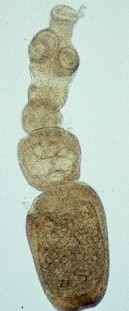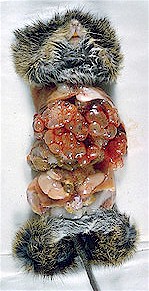Echinococcus multilocularis, the alveolar hydatid tapeworm, also called the small fox tapeworm, is a tapeworms parasite that has dogs and other canids (e.g. foxes, wolves, coyotes, etc.) and occasionally cats as final hosts.
Several rodents (e.g. mice, rats, voles, shrews, etc.) act as intermediate hosts. Humans can also become infected as intermediate or dead-end hosts.

Infection in intermediate hosts causes the appearance of hydatid cysts. The disease caused by Echinococcus multilocularis in intermediate hosts is called alveolar echinococcosis, alveolar hydatid disease, alveolococcosis or multilocular echinococcosis.
Echinococcus multilocularis does not affect cattle, sheep, goats, swine, horses or poultry.
Are dogs or livestock infected with Echinococcus multilocularis contagious for humans?
YES. The worm eggs shed with the feces of dogs, foxes and other canids can contaminate food and drinking water and are infective for humans as well as other animals. Contact with contaminated dogs can also be contagious, because their hair coat can carry such eggs as well. See the life cycle below.
You can find additional information in this site on the general biology of parasitic worms and/or tapeworms.
Final location of Echinococcus multilocularis
Predilection site of adult Echinococcus multilocularis worms is the small intestine.
Anatomy of Echinococcus multilocularis
Adult worms are rather small, 4 to 6 mm. They have only 3 to 4 segments, the last one being the largest and gravid, i.e. filled with eggs. The head (scolex) has 4 suckers and numerous hooks for attaching to the gut's wall. Otherwise, as other tapeworms, Echinococcus multilocularis has neither a digestive tube, nor circulatory or respiratory systems. It doesn't need them because each proglottid absorbs what it needs directly through its tegument.
Each proglottid has its own reproductive organs of both sexes (i.e. they are hermaphroditic) and excretory cells known as flame cells (protonephridia). The reproductive organs in each proglottid have a common opening called the genital pore. In young proglottids all these organs are still rudimentary. They develop progressively, which increases the size of the proglottid as it moves towards the tail. Mature gravid proglottids are full of eggs and detach from the strobila (the chain of segments) to be shed outside the host with its feces.
The eggs are have an ovoid shape and are rather small (30 to 40 micrometers). They are embryonated (i.e. contain already developed larvae called oncospheres or hexacanths) with a thick capsule radially striated.
The hydatid cysts develop in the liver and seldom in other organs of the intermediate host during years. Cysts of Echinococcus multilocularis (also called locules) are smaller than those of Echinococcus granulosus, their envelope is thinner. Inside the affected organ they often build clusters of small vesicles surrounded by connective tissue. Infected organs can have dozens if not hundreds of cysts. Each cyst is filled with more or less liquid and contains numerous heads of the parasite (protoscolices) produced through asexual multiplication.
Life cycle and biology of Echinococcus multilocularis

Echinococcus multilocularis has an indirect life cycle with dogs (and other canids) as final hosts, and numerous small rodents (mice, rats, voles, etc.) as well as humans as intermediate hosts.
Gravid segments fill with eggs are shed with the dog's feces hosts. Each adult worm deposits one gravid segment approx. every two weeks, and each gravid segment contains several hundred eggs. Once in the environment, survival of the eggs depends strongly on the climatic conditions and is lower by warm and dry weather. They are very resistant to cold and can remain infective for months.
Intermediate hosts ingest such eggs through contaminated food or water. Inside the intermediate host, the eggs release the hexacanths (larvae) in the intestine. They go thtough the intestinal wall, get into the portal vein and are transported to the liver. The capillaries in the liver act like a filter that retains numerous hexacanths, which develop to cysticercoids and produce the hydatid cysts. Very rarely the blood stream transports hexacanths to other organs or to the muscles.
The immature worms in the hydatid cysts do not complete development to adults there. They do it only once they get into a final host that has fed on a prey infected with hydatid cysts. In this case the young worms (protoscolices) are released after digestion of the cysts, attach to the gut's wall, complete their development to mature adults and start producing eggs.
The prepatent period (time between infection and recovery of first eggs in the feces) is 4 to 5 weeks. Development of the cysts in the intermediate hosts takes months and even years.
Harm caused by Echinococcus multilocularis infections, symptoms and diagnosis
For dogs and other final hosts Echinococcus multilocularis infections are benign, mostly without clinical signs, unless in case of very heavy infections, which are unusual.
For humans alveolar echinococcosis caused by Echinococcus multilocularis is even more serious than cystic echinococcosis due to Echinococcus granulosus. In fact, alveolar echinococcosis is highly lethal, one of the most dangerous human helminthiasis. It often causes a cancer-like destruction of vital organs, mainly the liver. The problem is that it develops very slowly over years and without symptoms. The incidence is very low, even in endemic regions like China, Siberia and Central Europe. But unfortunately it is increasing and spreading. One reason is the progressive colonization of urban and periurban environments by foxes, which makes it more likely for both dogs and humans to become infected.
Diagnosis in dogs cannot be based on egg identification in the feces, because Echinococcus eggs are undistinguishable from Taenia spp eggs. ELISA tests based on egg antigens in the feces are not as reliable as against Echinococcus granulosus. Newer PCR (Polymerase Chain Reaction) tests based on DNA from egg in the feces have also been investigated but availability is so far restricted to a few specialized laboratories.
Prevention and control of Echinococcus multilocularis
In endemic regions it is advisable to reduce the number of stray dogs and cats. Domestic and working dogs and cats should be kept away from hunting and feeding small rodents that could be contaminated, what is often very difficult to achieve.
Dogs and cats can be preventatively treated with approved taenicides. These products contain mainly broad-spectrum anthelmintic active ingredients such as benzimidazoles (e.g. albendazole, fenbendazole, febantel, mebendazole) or specific taenicides such as praziquantel and epsiprantel, the latter often in combination with nematicides (e.g. levamisole, milbemycin oxime, pyrantel, etc.) to cover a broader spectrum of worms.
Most of these pet wormers are available in formulations for oral delivery either as solids (tablets, pills, etc.) or as liquids (drenches, suspensions, etc.). There are also a few injectable and spot-on (= squeeze-on = pipettes) taenicides in some countries (mainly with praziquantel).
Most wormers kill the worms shortly after treatment and are metabolized and/or excreted within a few hours or days. This means that they have a short residual effect, or no residual effect at all. As a consequence treated animals are cured from worms but do not remain protected against new infections. To ensure that they remain worm-free the pets have to be dewormed periodically, depending on age and the local epidemiological, ecological and climatic conditions.
Other classic livestock anthelmintics such as macrocyclic lactones (e.g. ivermectin, selamectin, etc.), levamisole, tetrahydropyrimidines (e.g. pyrantel, morantel) and piperazine derivatives are not effective at all against whatever tapeworms.
So far there are no antiparasitic medicines for external use such as shampoos, soaps, sprays, powders, insecticide-impregnated collars, etc. that control established tapeworm infections.
These preventative measures are highly recommended also for urban dogs in endemic areas in order to prevent transmission of echinococcosis to humans.
Biological control of Echinococcus multilocularis (i.e. using its natural enemies) is so far not feasible.
You may be interested in an article in this site on medicinal plants against external and internal parasites.
Resistance of Echinococcus multilocularis to anthelmintics
So far there are no reports on resistance of Echinococcus multilocularis to anthelmintics in dogs or cats.
This means that if an anthelmintic fails to achieve the expected efficacy against this parasite, chance is very high that it is not due to resistance, but either the product was used incorrectly, or it was unsuited for the control of this parasite. Incorrect use is the most frequent reason for failure of antiparasitic drugs.
|
Ask your veterinary doctor! If available, follow more specific national or regional recommendations for Echinococcus multilocularis control. |